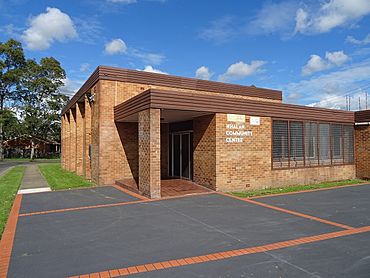Whalan, New South Wales facts for kids
Quick facts for kids WhalanSydney, New South Wales |
|||||||||||||||
|---|---|---|---|---|---|---|---|---|---|---|---|---|---|---|---|

Whalan Community Centre
|
|||||||||||||||
| Population | 5,929 (2021 census) | ||||||||||||||
| Postcode(s) | 2770 | ||||||||||||||
| Elevation | 47 m (154 ft) | ||||||||||||||
| Location | 45 km (28 mi) west of Sydney CBD | ||||||||||||||
| LGA(s) | City of Blacktown | ||||||||||||||
| State electorate(s) | Londonderry | ||||||||||||||
| Federal Division(s) | Chifley | ||||||||||||||
|
|||||||||||||||
Whalan is a suburb of Sydney, in the state of New South Wales, Australia. It is located about 45 kilometres west of the main Sydney central business district. Whalan is part of the City of Blacktown area and the larger Greater Western Sydney region.
History of Whalan
Whalan gets its name from James Whalan. He was given a large piece of land, about 300 acres (1.2 square kilometres), near Mount Druitt in 1831. This gift came from Governor Ralph Darling.
James's father was Sergeant Charles Whalan. He was an important guard for Governor Lachlan Macquarie. Sergeant Whalan was in charge of the Light Horse Guard. James Whalan was also an explorer. He explored areas like Jenolan Caves and the Blue Mountains. He even discovered a famous rock formation called Grand Arch. He found it while chasing a bushranger, who was like an outlaw from old times.
Who Lives in Whalan?
According to the 2021 census, there were 5,929 people living in Whalan. About 51.5% of the people were female, and 48.5% were male.
Many different backgrounds make up the community. About 11.0% of the people were Aboriginal and Torres Strait Islander. The most common backgrounds were Australian, English, Australian Aboriginal, Samoan, and Filipino.
Most people (61.2%) were born in Australia. Other common birthplaces included New Zealand, the Philippines, Samoa, Fiji, and England.
About 61.2% of homes spoke only English. Other languages spoken included Samoan, Arabic, Tagalog, Hindi, and Tongan.
People in Whalan have many different jobs. Some common jobs include machinery operators, labourers, office workers, and people who work in trades. There are also community service workers, sales workers, and professionals.
Parks and Fun in Whalan
Whalan has a big reserve with lots of space for sports. It has four soccer fields and four football fields. There are also many smaller parks around the suburb.
You can find a large go-cart track that is open every Saturday. On the eastern side of Whalan, there is RAAF Park. This park is a special memorial to a Royal Australian Air Force (RAAF) camp. This camp was located there during World War II.
There was also an old airfield nearby. The runway from that airfield still exists today. It is now the main road that leads to Whalan Reserve. Before the area was developed in the 1960s, the old Mount Druitt motor racing track used to run along this runway and parts of Luxford Road.
Schools in Whalan
Whalan has three public schools for students. These are Whalan Public School and Madang Public School. There is also Halinda, which is a special needs school.
Whalan High School used to be in the area. It closed after a big event involving Daily Telegraph newspaper. The newspaper wrongly called some students from Mount Druitt High School "failures." The newspaper later apologized and paid money to the students and teachers involved.
After this, several high schools in the area were closed. They were then reorganized into Chifley College. This college has different campuses in places like Dharruk, Shalvey, North St Marys, and Bidwill. Today, Halinda school and the PCYC (Police Citizens Youth Clubs) offices use the old grounds and buildings of Whalan High School.

